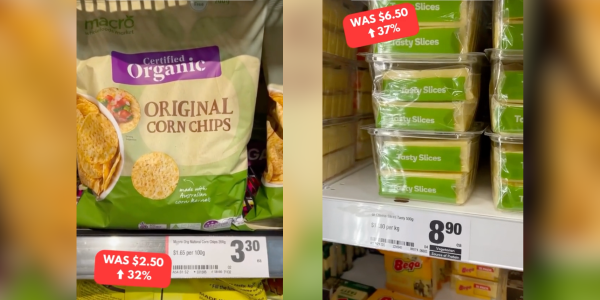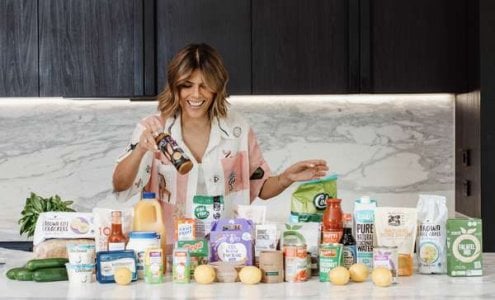Mum reveals how much you're paying for everyday grocery items: ‘This is interesting to see’
By
Seia Ibanez
- Replies 18
Supermarket shopping, once a mundane task, has become a dreaded experience for many as they grapple with the escalating cost of living.
The challenge of feeding their families without blowing the budget has become a daunting task.
But one mum has taken it upon herself to expose the shocking price increases on everyday items hitting Australian families hard.
According to Nabula Brdar, founder of the social media platform and app Supermarket Swap, prices of some items have surged by a staggering 33 per cent in the last 18 months at Woolworths alone.
Since December 2021, Brdar and her team have been meticulously recording the prices of over 2000 items weekly.
Their mission?

To help their customers find additive-free products at the most affordable prices.
In a video posted online, she revealed how a pack of Woolworths Macro Original Corn Chips, which cost $2.50 last year, now costs $3.00—a price hike of 31 per cent.
Similarly, a 500g pack of Woolworths Tasty Cheese Slices, priced at $6.50 in December 2022, now costs $8.40—an increase of almost 37 per cent.
While Brdar explained that the prices for Woolworths Macro Original Corn Chips and Woolworths Tasty Cheese Slices are $3.30 and $8.90, upon checking the website as of 13 December, the price indicated is $3.00 and $8.40, respectively.
The price increases are not the only thing that has caught Ms Brdar's attention. She has also noticed new guarantees supermarkets have started to use, such as locked prices.
‘We started thinking “wow, this is really interesting to see”,’ she said.
'The items we all know [have risen most] in Australia are items such as dairy, and that’s obviously because of the increases in industry that have been passed through the supermarket.’
‘Things we expected [have gone up] in that category, especially cheese and milk,’ she added.
You can watch her video below:
The categories that have seen the most significant price increases are frozen goods, followed by meat and seafood, dairy, eggs, fridge items, pantry items, and drinks.
However, it's worth noting that overall, food and grocery inflation—which sits at 4.8 per cent—is still lower than the headline inflation rate of 5.4 per cent.
In response to these revelations, a Woolworths spokesperson said, 'As we start to see the rate of inflation ease, we will continue to focus on delivering savings to our customers.’
‘We know Australians are feeling the strain of cost of living, and we are working to deliver relief in their weekly grocery shop, with dropped prices on hundreds of products and more than 6,000 specials every week.'
‘We’ve recently reduced the price of our Tasty Cheese slices by 50 cents,’ they added.
‘We are committed to offering our customers value while working with our suppliers to sensitively manage economy-wide pressures.’
Coles, even if it was not mentioned in the video, also acknowledged the impact of inflation on their prices.
A spokesperson from the supermarket stated, ‘We are working hard to keep prices affordable for Australian households. At Coles, we believe all Australians should be able to put quality food on the table at a good price—particularly as they face high cost of living pressure.’
'Our costs have increased due to inflation—construction costs, energy prices, logistics, packaging and other costs have all risen. Many suppliers are increasing their prices because they, too, are dealing with inflationary pressures to produce the products we sell in our supermarkets. All of these factors affect the price customers see at the checkout.'
‘For the July to September quarter, price inflation in Coles’ supermarkets declined to 3.1 per cent, down from 5.8 per cent the previous quarter. Fresh food—including produce, meat, deli and seafood—was in deflation at 2.3 per cent,’ they added.
‘Coles profit margin last financial year was 2.6 per cent. This means that for every $100 customers spend in our stores, Coles makes $2.60 profit. These profit margins have remained consistent since the 2020 financial year.’
According to the first quarter results, Coles and Woolworths’ meat, vegetable, fruit, and deli prices have dropped significantly by 14 per cent and 12 per cent, respectively, due to lower global input costs.
However, grocery inflation remained elevated for these two supermarkets compared to last year. You can read more about the story here.
Brdar was inspired to start Supermarket Swap after becoming a mum for the first time. She wanted to know what was in her food and make healthier choices for her family.
‘I decided I actually want to know what’s in my food,’ she said.
‘I started looking into that and then made the choice that I wanted to choose products on the shelf that were predominantly made from really recognisable ingredients.’
She mentioned that when she thought of the idea, most people believed that opting for fewer additives required growing everything from the beginning. While she admired those who had the time for that, as a mum, she just didn't have that luxury.
Brdar noted that a majority of Australians typically do their grocery shopping at Coles and Woolworths but often find themselves bewildered by endless choices.
The Supermarket Swap app was created to simplify those choices. It enables users to search for additives by name or code, explore specials, create shopping lists and meal plans, and even follow some recipes.

One of Brdar's favourite swaps is purchasing bread from the bakery section in supermarkets instead of the bread aisle. She frequently discovered that these options are preservative-free and come at half the price.
She also believed that the pandemic has made people more conscious of their health, but the current cost of living crisis has left them unsure of how to prioritise their well-being.
'Traditionally, I think health and eating better has been associated with people that have a really high weekly disposable income. And [breaking that idea is] something we’re really passionate about,' she said.
‘With the cost of living crisis, we make sure that everything we share in our social media community in swaps is the same price because we don’t want people to feel they have to be rich to be able to eat better.’
'We want it to be accessible to everybody. Especially when it comes to feeding children, we want all parents to feel they can make great choices, and it’s not going to result in blowing out their grocery bill.'
Her number one tip to save money at the grocery store is to meal plan but keep it realistic, as, she says, no one cooks seven nights a week.
 What are your thoughts on the rising cost of living in Australia? Have you noticed a significant increase in the price of everyday items? Share your tips for managing your budget in the comments below.
What are your thoughts on the rising cost of living in Australia? Have you noticed a significant increase in the price of everyday items? Share your tips for managing your budget in the comments below.
The challenge of feeding their families without blowing the budget has become a daunting task.
But one mum has taken it upon herself to expose the shocking price increases on everyday items hitting Australian families hard.
According to Nabula Brdar, founder of the social media platform and app Supermarket Swap, prices of some items have surged by a staggering 33 per cent in the last 18 months at Woolworths alone.
Since December 2021, Brdar and her team have been meticulously recording the prices of over 2000 items weekly.
Their mission?

A mum revealed in a video online the price increases of supermarket products. Credit @supermarket.swap / TikTok
To help their customers find additive-free products at the most affordable prices.
In a video posted online, she revealed how a pack of Woolworths Macro Original Corn Chips, which cost $2.50 last year, now costs $3.00—a price hike of 31 per cent.
Similarly, a 500g pack of Woolworths Tasty Cheese Slices, priced at $6.50 in December 2022, now costs $8.40—an increase of almost 37 per cent.
While Brdar explained that the prices for Woolworths Macro Original Corn Chips and Woolworths Tasty Cheese Slices are $3.30 and $8.90, upon checking the website as of 13 December, the price indicated is $3.00 and $8.40, respectively.
The price increases are not the only thing that has caught Ms Brdar's attention. She has also noticed new guarantees supermarkets have started to use, such as locked prices.
‘We started thinking “wow, this is really interesting to see”,’ she said.
'The items we all know [have risen most] in Australia are items such as dairy, and that’s obviously because of the increases in industry that have been passed through the supermarket.’
‘Things we expected [have gone up] in that category, especially cheese and milk,’ she added.
You can watch her video below:
The categories that have seen the most significant price increases are frozen goods, followed by meat and seafood, dairy, eggs, fridge items, pantry items, and drinks.
However, it's worth noting that overall, food and grocery inflation—which sits at 4.8 per cent—is still lower than the headline inflation rate of 5.4 per cent.
In response to these revelations, a Woolworths spokesperson said, 'As we start to see the rate of inflation ease, we will continue to focus on delivering savings to our customers.’
‘We know Australians are feeling the strain of cost of living, and we are working to deliver relief in their weekly grocery shop, with dropped prices on hundreds of products and more than 6,000 specials every week.'
‘We’ve recently reduced the price of our Tasty Cheese slices by 50 cents,’ they added.
‘We are committed to offering our customers value while working with our suppliers to sensitively manage economy-wide pressures.’
Coles, even if it was not mentioned in the video, also acknowledged the impact of inflation on their prices.
A spokesperson from the supermarket stated, ‘We are working hard to keep prices affordable for Australian households. At Coles, we believe all Australians should be able to put quality food on the table at a good price—particularly as they face high cost of living pressure.’
'Our costs have increased due to inflation—construction costs, energy prices, logistics, packaging and other costs have all risen. Many suppliers are increasing their prices because they, too, are dealing with inflationary pressures to produce the products we sell in our supermarkets. All of these factors affect the price customers see at the checkout.'
‘For the July to September quarter, price inflation in Coles’ supermarkets declined to 3.1 per cent, down from 5.8 per cent the previous quarter. Fresh food—including produce, meat, deli and seafood—was in deflation at 2.3 per cent,’ they added.
‘Coles profit margin last financial year was 2.6 per cent. This means that for every $100 customers spend in our stores, Coles makes $2.60 profit. These profit margins have remained consistent since the 2020 financial year.’
According to the first quarter results, Coles and Woolworths’ meat, vegetable, fruit, and deli prices have dropped significantly by 14 per cent and 12 per cent, respectively, due to lower global input costs.
However, grocery inflation remained elevated for these two supermarkets compared to last year. You can read more about the story here.
Brdar was inspired to start Supermarket Swap after becoming a mum for the first time. She wanted to know what was in her food and make healthier choices for her family.
‘I decided I actually want to know what’s in my food,’ she said.
‘I started looking into that and then made the choice that I wanted to choose products on the shelf that were predominantly made from really recognisable ingredients.’
She mentioned that when she thought of the idea, most people believed that opting for fewer additives required growing everything from the beginning. While she admired those who had the time for that, as a mum, she just didn't have that luxury.
Brdar noted that a majority of Australians typically do their grocery shopping at Coles and Woolworths but often find themselves bewildered by endless choices.
The Supermarket Swap app was created to simplify those choices. It enables users to search for additives by name or code, explore specials, create shopping lists and meal plans, and even follow some recipes.

The Supermarket Swap app helps customers find alternative food choices at affordable prices. Credit: Supermarket Swap
One of Brdar's favourite swaps is purchasing bread from the bakery section in supermarkets instead of the bread aisle. She frequently discovered that these options are preservative-free and come at half the price.
She also believed that the pandemic has made people more conscious of their health, but the current cost of living crisis has left them unsure of how to prioritise their well-being.
'Traditionally, I think health and eating better has been associated with people that have a really high weekly disposable income. And [breaking that idea is] something we’re really passionate about,' she said.
‘With the cost of living crisis, we make sure that everything we share in our social media community in swaps is the same price because we don’t want people to feel they have to be rich to be able to eat better.’
'We want it to be accessible to everybody. Especially when it comes to feeding children, we want all parents to feel they can make great choices, and it’s not going to result in blowing out their grocery bill.'
Her number one tip to save money at the grocery store is to meal plan but keep it realistic, as, she says, no one cooks seven nights a week.
Key Takeaways
- Nabula Brdar, founder of the Supermarket Swap app, exposed what she claims to be shocking price increases in supermarkets in Australia.
- She notes that prices of some items have increased by 33 per cent in the last 18 months at Woolworths alone.
- Some of the most notably increased items are in categories such as dairy, frozen goods and meat and seafood.
- In response to inflation concerns, a Woolworths spokesperson stated that they are working to deliver relief in their weekly grocery shop with dropped prices and specials, and a Coles spokesperson highlighted that they are working to keep prices affordable for Australian households as they also deal with increased costs due to inflation.







